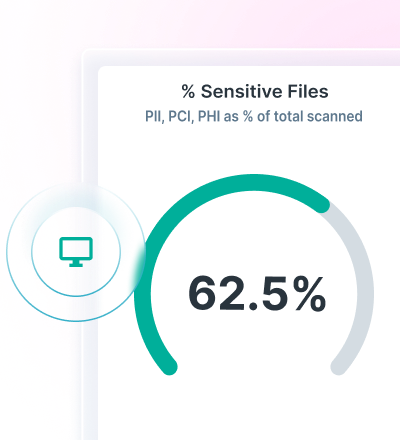Comprehensive Guide to Data Security Posture Management (DSPM)
0 Minuten Lesezeit

Lionel Menchaca
Sometimes it is just too late. A notification pops up at 3 a.m. and you find out sensitive data is already exposed. In the hours that follow, every conversation circles back to three questions: How did it happen? What was stolen? How can we prevent it from happening again?
Those are hard questions to answer when you do not know where sensitive data lives, who has access or how it moved in the days and weeks before the breach. Spreadsheets and manual audits cannot keep up with cloud-first collaboration, SaaS sprawl and AI tools that create and copy data at speed.
Data Security Posture Management (DSPM) gives security and compliance teams a live picture of their data estate. It discovers sensitive information, classifies it accurately and tracks how exposure changes over time so you can spot risk before attackers do. When an incident happens, DSPM helps you quickly see which data was involved, where it was stored and which identities and systems touched it.
This guide explains how DSPM strengthens your ability to detect issues earlier, contain active incidents faster and answer tough post-breach questions with confidence. It also shows how Forcepoint DSPM uses AI-driven classification and fast discovery to reduce exposure, increase trust and simplify compliance across dynamic environments.
What Is Data Security Posture Management (DSPM)?
Organizations need a consistent way to understand sensitive data across every environment. DSPM provides the structure to discover, classify and manage data risk at scale. It identifies sensitive data wherever it resides, determines who can access it and evaluates whether that access is appropriate.
DSPM helps organizations answer questions that traditional security tools cannot resolve:
- What regulated data do we have?
- How is it being shared?
- Who has permissions to access it?
- Is it stored in the correct location?
- How is data risk trending over time?
DSPM also addresses dark data and shadow data. Dark data includes information the organization does realize that it has. Shadow data represents duplicated, abandoned or overshared content found across cloud and SaaS systems that falls outside formal governance. These categories create unnecessary security, privacy and compliance risk.
DSPM provides a unified inventory of sensitive information across cloud, SaaS, endpoints and on-prem systems. By keeping this inventory current, organizations gain the visibility they need to reduce exposure and enforce more consistent governance.
Here's an overview of how Forcepoint DSPM works:
How DSPM Works: Core Components
Successful DSPM solutions share core components that work together to establish and maintain strong data posture.
Data Discovery
Discovery is the first step in DSPM. For more on how discovery uncovers sensitive assets, see DSPM locates and identifies sensitive data. DSPM scans cloud storage, SaaS applications, file servers and other repositories to build a current inventory of data assets. It highlights early signs of risk such as public links, inappropriate permissions or sensitive files stored in unexpected locations.
Continuous discovery ensures posture reflects real conditions, not periodic snapshots.
Data Classification
Classification identifies which files contain sensitive or regulated content. DSPM uses pattern detection and machine learning to classify PII, PHI, PCI, financial data, intellectual property and other categories. Modern classification analyzes meaning and context, not just keywords, which reduces false positives. For additional detail, see discovery and AI classification.
Risk Analysis and Prioritization
DSPM analyzes factors such as exposure levels, access patterns, file age, content sensitivity and business context. It correlates these signals to prioritize risk. High-impact exposures rise to the top of the queue so teams can act quickly. This reduces noise and improves efficiency. To explore this further, see analyze data risk.
Posture Assessment and Monitoring
Data posture changes often as users create content, adjust access settings or share files. DSPM monitors these changes continuously, updating risk insights and posture assessments automatically. This ensures decisions are based on current information.
Remediation Support and Automated Workflows
Remediation is where DSPM moves from visibility to impact. Once risks are discovered and prioritized, teams need repeatable ways to close gaps without drowning in tickets.
Modern DSPM platforms support an automation spectrum:
- Manual remediation
Analysts use DSPM insights to update permissions, remove public links, relocate sensitive files or delete redundant data. This is useful for complex, high judgment scenarios. - Guided remediation
DSPM groups exposures by owner, system or business unit and recommends specific fixes. Analysts or data owners get one-click actions and prebuilt playbooks to restrict sharing, tighten access or move content to safer locations. - Automated remediation
For well-understood patterns, policy-driven workflows run without manual review. Examples include automatically removing public links from folders tagged as highly confidential, revoking access for stale guest accounts or quarantining sensitive files that appear in unsanctioned locations.
This automation spectrum supports a least privilege model without slowing the business. Teams can start with manual review, move to guided remediation as confidence grows and reserve full automation for repeatable scenarios where the risk and the correct response are clear.
Over time, automated remediation reduces dwell time for exposed data, shrinks the attack surface and frees analysts to focus on investigations, threat hunting and strategic improvements instead of repetitive cleanup.
Forcepoint Data Security Posture Management (DSPM)
Organizations need DSPM that provides speed, accuracy and dependable performance across modern hybrid environments. Forcepoint DSPM delivers this through a two-phase scanning strategy engineered for scale and efficiency. Phase 1 uses high-speed metadata cataloging to inventory millions of files with minimal API calls, which gives organizations rapid visibility into their cloud, SaaS and on-prem data. Phase 2 then applies deep inspection only to content that shows signs of risk. This selective approach prevents cloud API throttling, reduces processing time and eliminates the delays that often limit the value of traditional DSPM platforms.
Classification accuracy is equally important. Forcepoint DSPM uses an AI Mesh architecture that combines multiple specialized AI models, each trained for specific aspects of content understanding. At the center is a Small Language Model (SLM) that interprets semantic meaning, intent and contextual relationships within data. Supporting classifiers analyze patterns, file structure and contextual indicators to reinforce precision. Because AI Mesh can be trained with customer-specific examples, accuracy improves over time while false positives continue to decline.
Strong posture management requires more than discovery and classification. Forcepoint DSPM includes built-in remediation powered by custom playbooks that enable teams to remove public links, restrict overshared content, correct misaligned permissions or notify data owners. High classification precision allows these actions to run confidently, reducing the risk of unnecessary interruption while still maintaining strong governance.
Forcepoint DSPM also aligns closely with broader data security programs. It integrates with Forcepoint DDR to provide visibility into data-in-use activity, extending posture insights into how users interact with sensitive information. This supports stronger monitoring for unauthorized changes, suspicious activity or misuse. For organizations modernizing compliance programs, regulatory compliance with GenAI provides additional guidance on how DSPM strengthens oversight as AI becomes more embedded in business workflows.
DSPM also plays a key role in AI governance. DSPM for AI explains how Forcepoint helps organizations prevent sensitive information from entering prompts, training data or agent-assisted workflows. This is increasingly important as AI systems produce new content that must be evaluated and governed like any other business data.
Finally, Forcepoint DSPM supports both structured and unstructured data at enterprise scale. Its ability to scan hybrid and multi-cloud environments, across distributed global file systems, helps organizations maintain consistent visibility even as data becomes more fragmented. Together, these capabilities create a flexible and resilient DSPM solution that delivers reliable classification, actionable risk insights and safer remediation across the full data estate.
Behavioral Analytics and Anomaly Detection in DSPM
Finding exposed data is only part of the story. The next step is understanding how people interact with that data and when behavior starts to look wrong.
DSPM builds the map of sensitive data and exposure. When paired with continuous monitoring from tools like Forcepoint DDR, you also get a baseline of normal file activity - who usually accesses which repositories, how data is shared and what “busy but safe” looks like in your environment.
Behavioral analytics compares new events to that baseline. Unusual spikes in access to high-value repositories, large downloads outside typical hours or sudden permission changes for sensitive folders can be flagged as anomalies even if they technically follow policy. This helps teams spot early indicators of insider risk or compromised accounts before data leaves their control.
Because analytics focus on behavior around the most sensitive data, they also reduce false positives. Routine access to low-risk content generates fewer alerts. Risk scoring pulls truly suspicious activity – like stockpiling sensitive files or atypical sharing to external accounts - to the top of the queue so analysts spend more time on real threats and less time on noise.
Over time, this combination of DSPM context and behavior analytics improves both detection and response. Teams see not just where exposure exists but how it is being used, which identities are involved and which anomalies need immediate investigation.
Top Benefits of Using a DSPM Solution
DSPM strengthens data governance, improves security posture and supports operational efficiency.
1. Full Visibility Across Cloud, SaaS and On-Prem Data
DSPM provides a complete view of where sensitive data lives, who can access it and how it is shared. This visibility helps teams uncover blind spots such as abandoned repositories, outdated permissions or files copied into unmanaged systems.
2. Protection for AI and GenAI Programs
DSPM prevents regulated data from entering AI training sets or prompt streams and identifies when AI-generated content includes sensitive information. It supports safer and more compliant AI adoption across the enterprise.
Here's How Forcepoint DSPM protects data in ChatGPT:
3. Reduced Risk Through Accurate Classification
Accurate classification surfaces high-impact exposures including external file sharing, sensitive content in public locations or inherited permissions that no longer match data sensitivity. DSPM helps teams address the issues that matter most.
4. Simplified Compliance
DSPM identifies regulated data, classifies it accurately and generates compliance-focused reports aligned with GDPR, HIPAA, CCPA, PCI and other frameworks. It reduces evidence-gathering time and audit fatigue. For additional detail, see automate compliance reporting.
5. Improved Productivity and Lower Costs
DSPM automation reduces manual investigation and frees teams from time-consuming classification tasks. Removing redundant, obsolete and trivial (ROT) data lowers storage costs and improves system performance. DSPM also helps maintain correct access levels, which reduces user friction.
How DSPM Helps CISOs and Security Leaders
CISOs live in metrics and board conversations. When a breach happens, they must explain what was exposed, how it happened and how risk is trending over time. DSPM gives them the evidence to tell that story with confidence instead of guesswork.
At the executive level, DSPM turns technical findings into clear signals. CISOs can track how much high-value data is properly protected, which business units drive the most exposure and how quickly teams are closing critical misconfigurations. That supports more focused conversations with boards, regulators and business stakeholders.
DSPM insights also feed executive dashboards. CISOs get a live view of top data risks, open remediation actions and trend lines for exposure reduction. That makes it easier to justify investments, show progress on strategic initiatives and prove that data security posture is moving in the right direction.
Best Practices for CISOs Implementing DSPM
CISOs need a practical plan for deploying DSPM successfully. The following steps help establish a strong foundation.
1. Start With a Clear Scope and Stakeholders
Define which data repositories, users and environments will be included in the first phase. Clear scoping leads to faster wins and broader buy-in.
2. Build a Strong Data Inventory
A reliable inventory is essential for posture management. Begin with discovery to understand where sensitive information resides and how it is accessed.
3. Tune Classification to Match Business Language
Adapt classification models to reflect organizational terminology, document types and definitions of sensitive data. This improves accuracy and relevance.
4. Align Policies to Real Use
Review how teams collaborate and share content. Adjust policies to preserve productivity while still reducing risk.
5. Connect DSPM to Daily Operations
Integrate DSPM with tools such as DLP and DDR to maintain visibility across data at rest, in use and in motion. This helps security teams enforce consistent policy across workflows.
DSPM in Your Security Ecosystem
DSPM is most effective when it plugs into the rest of your security stack. It should not be another dashboard that teams rarely open. It should be the data map and risk engine behind your existing tools and workflows.
On Forcepoint Data Security Cloud, DSPM works alongside Data Detection and Response (DDR) and Data Loss Prevention (DLP) to cover data at rest, in use and in motion. DSPM discovers and classifies sensitive data across cloud, SaaS and on-prem. DDR continuously monitors how that data is used and responds to emerging threats. DLP enforces policy everywhere people work, from email and web to SaaS and endpoints.
The DSPM and DDR integration brings posture and continuous monitoring together. DSPM findings give DDR context about which repositories and data types matter most. DDR, in turn, surfaces suspicious behavior around high value data so teams can respond faster while reducing noise from low risk activity.
The DSPM plus DLP integration extends that story to enforcement. DSPM’s AI Mesh improves classification quality, DDR highlights active risk and DLP applies consistent policies across email, web, SaaS, endpoints and cloud. Together they help organizations move toward least privilege access, reduce oversharing and stop data loss through the same policy framework.
Beyond the Forcepoint stack, DSPM and DDR insights can feed SIEM and SOAR platforms so existing playbooks can act on high risk data exposures. DSPM classifications and risk scores can also inform CASB and CNAPP controls, shaping access policies for sensitive applications and cloud workloads. The result is a security ecosystem that understands where critical data lives, how it is used and when behavior around it becomes risky.
For CISOs and architects, this means DSPM becomes a shared source of truth for data risk, not a standalone project. It supports better decisions in incident response, investment planning and long term data governance.
Most Common DSPM Use Cases
DSPM supports a wide range of operational, compliance and AI-driven needs.
Safely Enabling GenAI
AI and GenAI tools can unintentionally expose sensitive information. DSPM helps prevent regulated data from entering prompts or training sets and flags AI outputs that require additional governance.
Data Access Governance
DSPM strengthens Data Access Governance by revealing overshared files, inherited permissions that no longer apply and data that requires stricter controls. DSPM provides context that static entitlement systems often lack.
AI Data Classification
DSPM identifies sensitive information within AI-generated content, chat logs and unstructured documents. It provides consistent classification across cloud and SaaS environments, improving labeling accuracy.
Data Risk Mitigation
DSPM reveals overshared data, sensitive content stored in incorrect locations and external collaborators with access to restricted information. It guides remediation to reduce the attack surface.
Cloud and SaaS Data Protection
DSPM identifies sensitive files in platforms such as OneDrive, SharePoint, AWS and Google Drive. It clarifies who has access and how content is shared.
Compliance and Audit Readiness
DSPM supports compliance teams by identifying regulated data and generating clear reports aligned with major frameworks. This reduces preparation time and improves audit accuracy.
Shadow Data and ROT Cleanup
DSPM uncovers abandoned or duplicated content that increases risk. It guides cleanup activities that reduce exposure and streamline governance.
Industry Use Cases: DSPM in Action
DSPM looks different in every sector, but these real world examples show how it solves industry specific data risks and compliance pressure.
Financial services: FBD Insurance
FBD Insurance handles highly sensitive customer PII, medical claims, financial records and regulatory documentation under intense scrutiny from GDPR and local regulators. Forcepoint DSPM and DDR help FBD map and classify critical data across its environment, cut through alert noise and focus on high risk incidents that matter most to the business. The team generates regulator ready evidence and gives board members clear visibility into data risk and remediation progress.
Aviation and manufacturing: Global aviation leader
A global aviation leader building propulsion systems and aircraft structures needed to protect controlled and classified information while executives push hard into AI. Forcepoint DSPM, DLP and DDR give security teams accurate classification of sensitive engineering and export controlled data, unified policies across email, web and cloud and stronger governance around AI models. With AI Mesh powered DSPM, they gain better visibility into where sensitive designs live and how they move so they can embrace AI without exposing crown jewel IP.
Consumer finance: Mariner Finance
Mariner Finance is a consumer lender that manages large volumes of PII and payment data under PCI and ISO 27001 style expectations. The company is rolling out Forcepoint DSPM as part of a broader Data Security Everywhere strategy to spot data exfiltration risks, tune hundreds of DLP policies and reduce false positives. DSPM helps them understand where sensitive data resides across a distributed footprint, prioritize remediation and support a complete framework for proactive risk management and streamlined compliance.
Latest DSPM Trends for 2026
DSPM continues to evolve as data volume grows and AI adoption increases.
1. Shadow Data Discovery at Scale
SaaS adoption continues to create more shadow data. Scalable DSPM is essential for identifying and managing this content.
2. AI-Driven Classification and Remediation
AI improves accuracy, strengthens risk scoring and accelerates remediation.
3. Hybrid Environment Coverage
Organizations need DSPM that covers on-prem, cloud, SaaS and AI environments consistently.
4. Continuous Monitoring
DDR integrations improve visibility into data-in-use events and support responsive posture management.
DSPM vs Other Data Security Tools: Main Differences
Security teams rely on multiple tools, but DSPM stands apart by focusing on sensitive data itself rather than the infrastructure surrounding it.
DSPM vs DLP
DLP protects data in motion by monitoring uploads, transfers and external sharing. DSPM protects data at rest across cloud and on-prem repositories. Together with DDR, these tools provide lifecycle protection across creation, storage, sharing and movement.
DSPM vs CSPM
CSPM identifies cloud configuration issues and identity misconfigurations. It protects the environment but cannot evaluate the data stored inside it. DSPM fills this gap by scanning repositories, identifying sensitive content and revealing exposure created by access permissions or sharing. It answers questions CSPM cannot, such as which files contain regulated data and where they may be overshared.
DSPM vs SSPM
SSPM governs SaaS configuration and security settings. It protects how applications are configured but does not evaluate the content stored in them. DSPM analyzes content inside SaaS platforms, classifies sensitive data and surfaces exposure, providing deeper visibility into business risk.
DSPM vs Data Access Governance (DAG)
DAG manages user entitlements and ensures access is appropriate. DSPM identifies which data requires strict controls and provides context that informs access decisions. DSPM helps DAG tools enforce the right permissions based on data value, not just user roles.
Why DSPM Completes the Picture
CSPM protects cloud settings, SSPM protects SaaS configurations, DLP protects data in motion and DAG governs access. DSPM provides visibility into sensitive data itself. Together, these solutions deliver complete protection across the data lifecycle.
Getting Started with the Right DSPM Solution
Organizations should evaluate DSPM solutions based on visibility, scalability, accuracy and integration with existing controls. For guidance, see choosing a DSPM solution.
Choose DSPM that can scan large environments quickly, classify content with precision and support efficient remediation. Solutions that combine high-speed discovery with context-aware classification reduce operational burden and improve security outcomes. Forcepoint DSPM delivers these capabilities with fast cataloging, accurate AI-driven classification and integrated remediation that helps organizations reduce exposure quickly.
DSPM becomes even more valuable when it clarifies how sensitive data moves across cloud and SaaS platforms. For examples of where DSPM provides the greatest impact, review DSPM use cases that show how organizations strengthen governance, prepare for AI and protect cloud-first workflows.
DSPM also reduces long-term operational debt by helping teams clean up legacy data stores, ROT data and abandoned content. To see how DSPM and DDR simplify maintenance, explore how they can reduce technical debt risk in distributed environments.
When selecting a DSPM platform, prioritize solutions that unify discovery, classification, risk insights and remediation. A solution that identifies sensitive data accurately, reduces exposure efficiently and enforces consistent policy across data at rest, in use and in motion will deliver the strongest results. Forcepoint DSPM provides this foundation for organizations seeking a more resilient and sustainable data security posture.

Lionel Menchaca
Mehr Artikel lesen von Lionel MenchacaAs the Content Marketing and Technical Writing Specialist, Lionel leads Forcepoint's blogging efforts. He's responsible for the company's global editorial strategy and is part of a core team responsible for content strategy and execution on behalf of the company.
Before Forcepoint, Lionel founded and ran Dell's blogging and social media efforts for seven years. He has a degree from the University of Texas at Austin in Archaeological Studies.
 Gartner®: Market Guide for Data Security Posture ManagementRead the Report
Gartner®: Market Guide for Data Security Posture ManagementRead the Report
X-Labs
Get insight, analysis & news straight to your inbox

Auf den Punkt
Cybersicherheit
Ein Podcast, der die neuesten Trends und Themen in der Welt der Cybersicherheit behandelt
Jetzt anhören









